feature
How Can DNA Help Exonerate Those Wrongly Convicted?
Flipping a traditional DNA crime lab to center issues of social justice
The Science Teacher—July/August 2022 (Volume 89, Issue 6)
By Hanako Osuga, Jason Foster, Jeanne Ting Chowning

Increasingly, science teachers are seeking phenomena that will allow them to explore both scientific content and socially relevant issues. We describe a series of lessons that (1) model the exoneration of wrongly convicted individuals using the science of DNA analysis and (2) contextualize individual cases within a larger system where Black people and other people of color are disproportionately incarcerated. By simply flipping a popular forensics scenario from establishing guilt to proving the innocence of someone wrongfully convicted, teachers can situate student learning in a contemporary social justice phenomenon that fosters critical analysis and that is also academically rigorous (Mackenzie 2020; Morrison, Bell, and Rhinehart 2019).
The United States has the highest incarceration rate in the world and imprisons more than 2.2 million people (Wilkerson 2020). If the U.S. incarcerated population was a city, it would be the fifth largest in the nation and would have three times as many Black people as compared to the rest of the nation (Wilkerson 2020). These lessons explore the reasons for this disparity. They provide students with information to understand not only how science can be used in the service of social justice, but also presents an opportunity to create an action plan to disrupt racist practices that are systemic in the US criminal legal system.
This work was inspired by an anti-racist biology course created and taught by Jason Foster (Foster 2020). The Science Education Team at the Fred Hutchinson Cancer Center adapted and expanded these lessons in collaboration with Mr. Foster. Our stance—consistent with the Next Generation Science Standards (NGSS) (see Nature of Science standards, Appendix H)—is that the process of science is a human endeavor and cannot be isolated from the social, historical, and political contexts in which it unfolds (NGSS Lead States 2013). The canonical framework of science assumes science to be neutral and apolitical, but it is not; racist scientific and medical research has a long history (see Washington 2006 for examples). Therefore, it is important that educators discuss how science can be used in anti-racist ways. Our intent with this set of lessons is to provide teachers with a way to address socio-political dimensions of race-related topics in the biology or biotechnology classroom while also providing students with a solid understanding of the science behind forensic analysis.
Lesson overview
We describe a seven-lesson, two-week sequence designed for high school biology or biotechnology courses that incorporates concepts related to DNA and genetics and which encourages sense-making about a social justice–related phenomenon (see Figure 1). Before beginning this unit, students should ideally have a basic background in DNA and genetics, although the introductory lessons can be used to introduce these topics. Throughout the lessons students work to answer three questions:
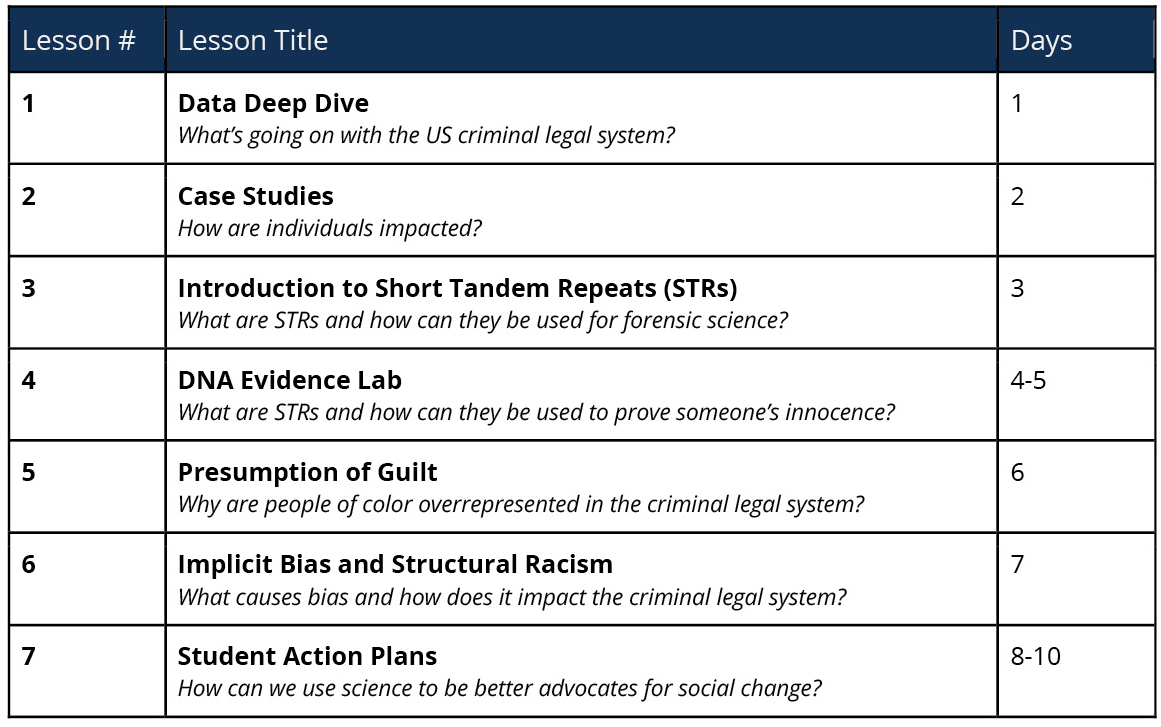
Lesson sequence and timeline.
These questions drive three-dimensional learning of science standards from NGSS as well as build toward social justice standards set by Learning for Justice (NGSS Lead States 2013; Learning for Justice 2018).
What’s going on with the U.S. criminal legal system? (Lesson 1)
Students begin this lesson sequence by analyzing graphs that show the many inequities across the U.S. criminal legal system. First, the whole class collaboratively examines a graph of the U.S. incarcerated population over time and explores why such a sharp increase in incarceration has been documented in the last few decades. This helps model the process of analyzing such data. Next, students break into smaller groups. Each group receives a new graph to discuss. Groups look for patterns in the data to make claims based on evidence presented in their graph. Then, the groups come back together to present their findings to each other and to look for broader patterns across all graphs. A student worksheet helps scaffold analysis and discussion, and the graphs are available on the worksheet as well as on a PowerPoint deck that the teacher can use to facilitate conversation. Finally, students analyze one last graph together as a class and are pointed toward two inequities in particular that surfaced from this last data visualization: the proportional overrepresentation of Black people in both incarcerated and exonerated populations (see Figure 2). This proportional overrepresentation in the exonerated as compared to the incarcerated population calls into question claims of “inherent” criminality in Black communities and also provides an example of an injustice (wrongful conviction) that students can investigate in subsequent lessons.
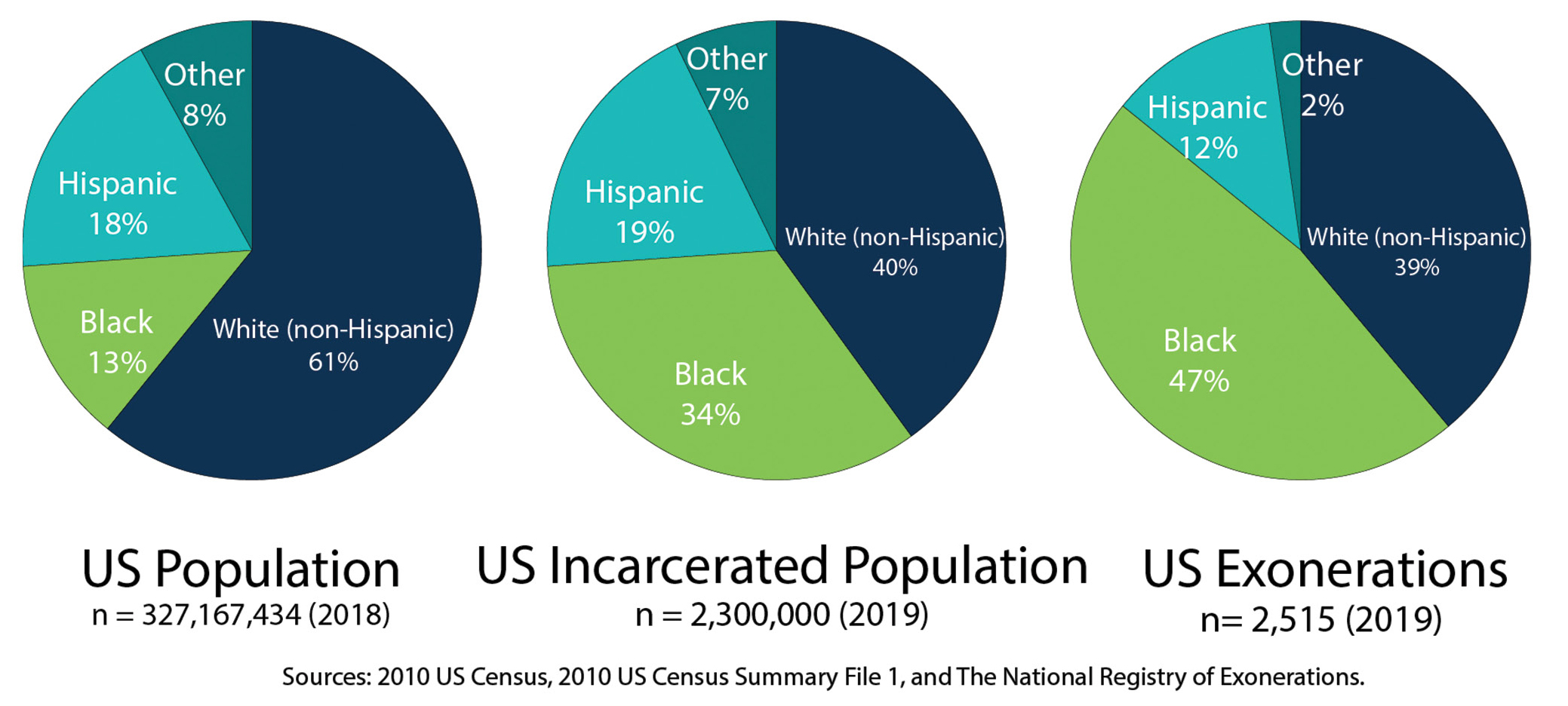
Graph for student analysis (Lesson 1).
How does DNA technology allow us to compare an individual’s DNA to crime scene evidence? (Lessons 2–4)
Over the next three lessons, the classroom can be conceived of as a larger social justice organization working to use DNA technology to help establish the innocence of those wrongly convicted (e.g., The Innocence Project or Equal Justice Initiative). In Lesson 2, students read one of five case studies included with the lesson in small groups. The case studies are based on real profiles from the National Registry of Exonerations (see Figure 3). Teachers can use the case studies provided or use the registry to make their own. The featured individuals are appealing for post-conviction DNA testing to overturn their wrongful convictions. Students analyze the evidence that was part of the original case and was used to convict these individuals.
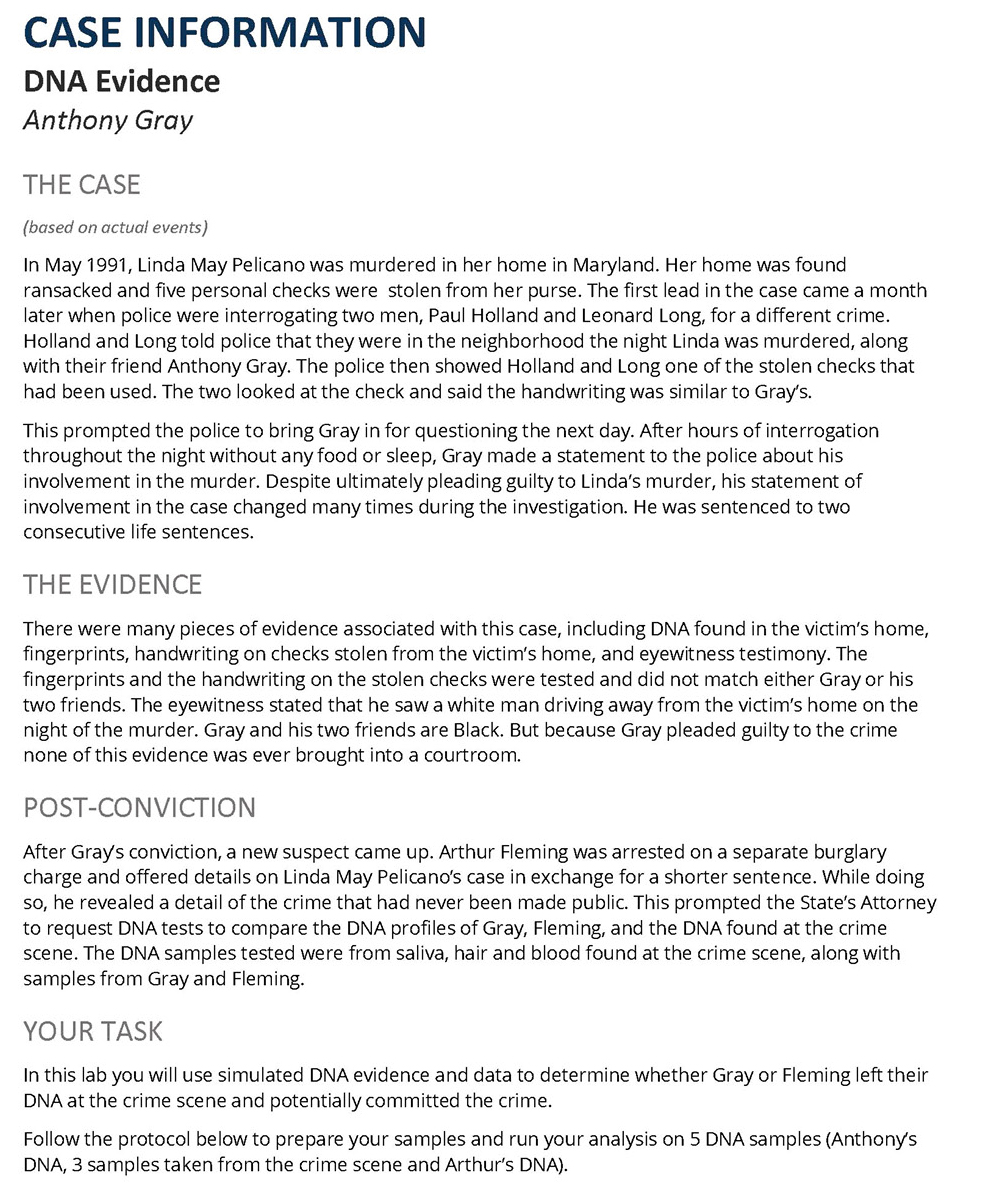
Sample case study.
In Lesson 3, students are introduced to DNA forensics and learn about Short Tandem Repeats (STRs). These hypervariable DNA regions can be used to create a “fingerprint” of an individual and accurately identify them. At each repeat site (locus), an individual has a unique number of these three to five base pair sequences, which results in fragments of DNA of different lengths (see Figure 4). After many copies of these fragments are made (i.e., amplified by PCR), they can be visualized using gel electrophoresis and compared to determine if DNA left at a crime scene matches an individual’s DNA. Students practice this method of analysis in a paper STR activity. They read a simulated gel and interpret the results as STR genotypes before running their own gel electrophoresis analysis.
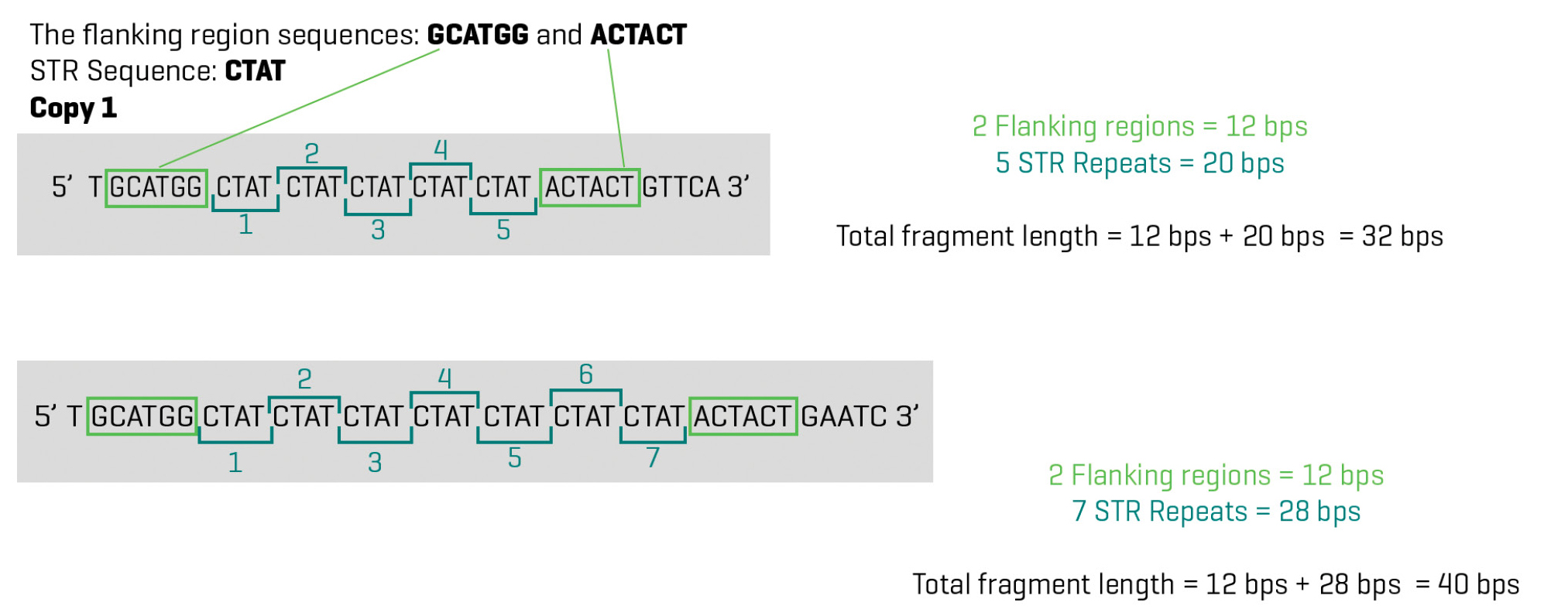
Flanking region example diagram.
The diagram shows one STR locus in an individual’s genome. In Copy 1, there are 5 repeats in Copy 2 there are 7 repeats. These differences can be analyzed using DNA analysis.
In Lesson 4, students model the process of conducting post-conviction DNA testing by running various fragments of DNA (representing post-PCR samples) in a gel (see Figure 5). They analyze their fragment patterns using a mock database to determine the genotype of their samples. Teachers can use the same reagents/materials they have used previously for crime labs and simply change the scenario for this lab. It is important to provide personal protective equipment to students if doing the lab face-to-face and to consider other safety precautions (see NSTA’s Minimum Safety Practices and Regulations as a guide). Students, including those in a remote learning context, can alternatively analyze images of pre-run gels that are provided in the curriculum.
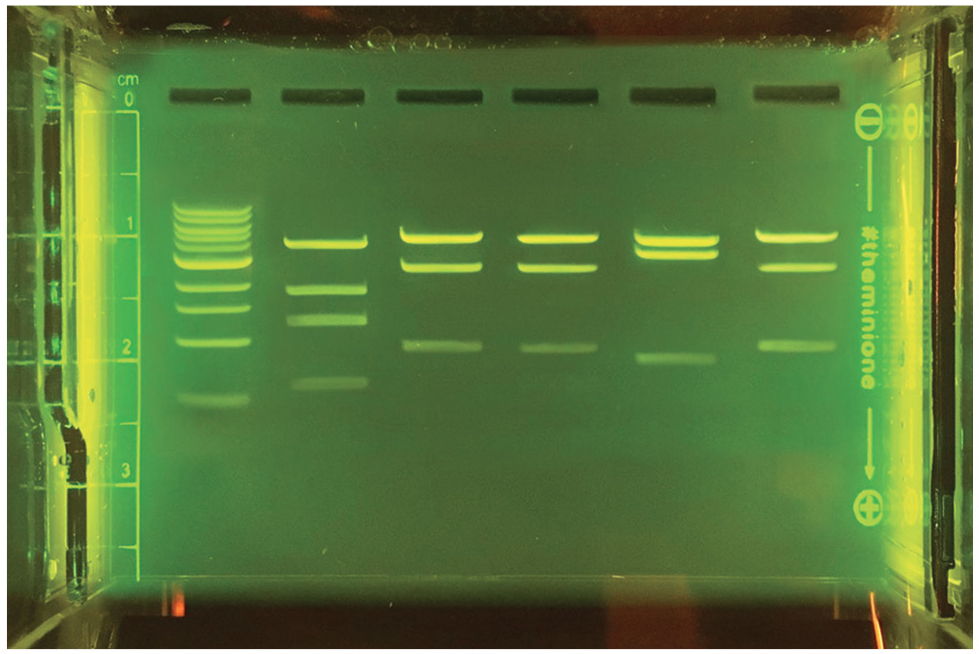
Gel electrophoresis picture.
From left to right: DNA Ladder, case study individual’s DNA sample, crime scene samples 1-4.
Students analyze their gel electrophoresis results using DNA fragment lengths, STR genotype information, and a simulated STR database. They determine the genotypes of the two STR loci to create an STR profile for each sample. Students then decide if the STR profile from their case study individual matches that of the DNA from the original crime scene (Figure 6A). Students use a second database to calculate the statistical probability of the profile match to calculate the significance of their results (Figure 6B). This process offers students a chance to engage with computational thinking and provides a math connection. Using this evidence, each group writes a recommendation to the courts on behalf of their individual, appealing to overturn their wrongful conviction.
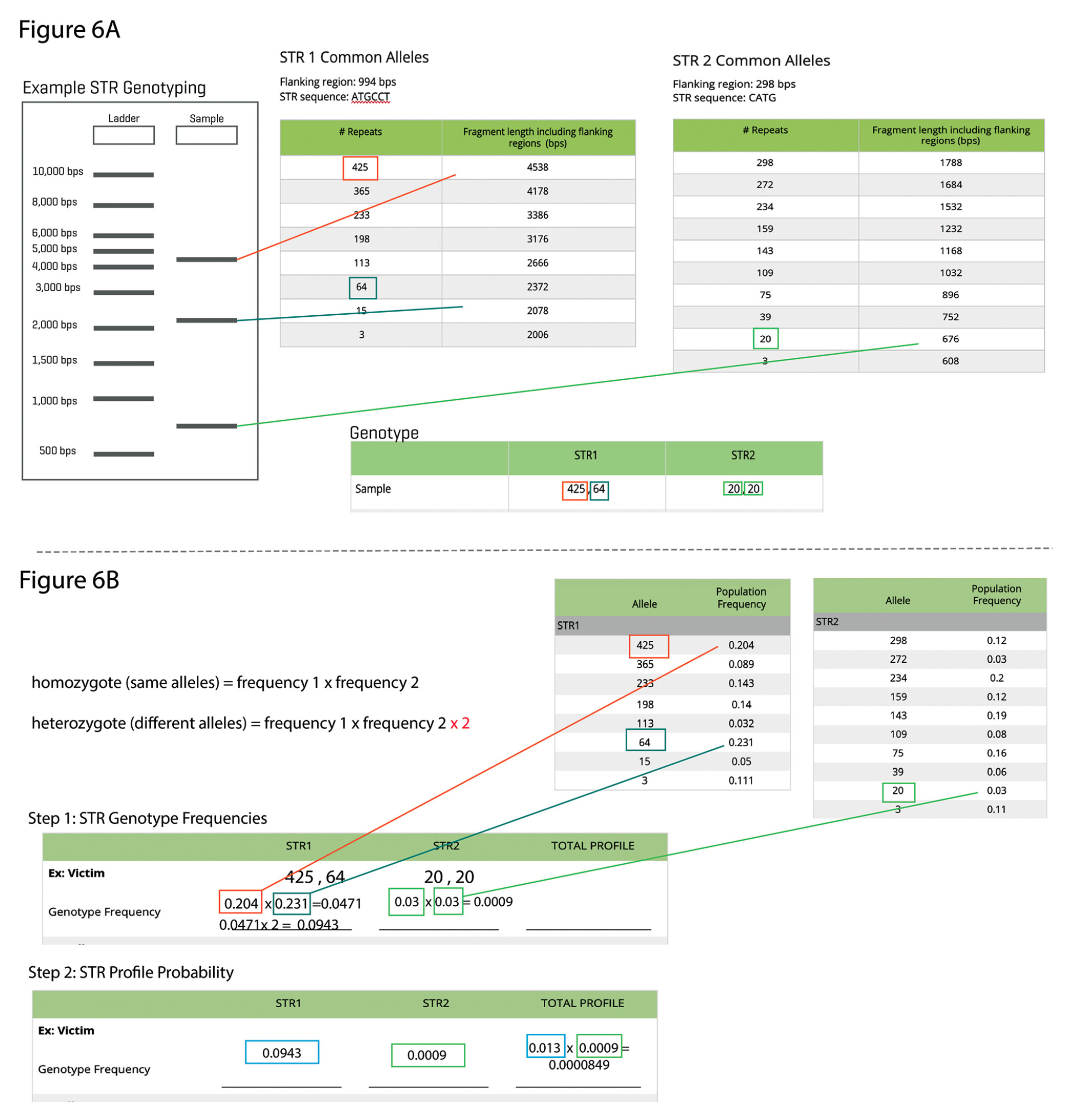
Example student STR analysis (2 loci).
(6a) Example student STR profile genotyping from a simulated gel, (6b) Example student STR profile probability
calculations.
Students present their case studies and their findings to each other in a postlab discussion. Through these presentations, students learn about other case studies and the variety of different injustices that lead to each person’s wrongful convictions. The five case studies were chosen to represent the most common proximal factors contributing to wrongful convictions (National Registry of Exonerations 2012).
Why are people of color overrepresented in the criminal legal system? (Lessons 5–6)
In Lesson 5 students read “John Lewis and Bryan Stevenson on The Presumption of Guilt” to explore the authors’ arguments about the presumption of guilt placed on Black men by society (Lewis and Stevenson 2013). Students use a Discussion Diamond (Colley 2016) format for small-group discussion to explore how the presumption of guilt is an underlying proximal cause of the contributing factors identified in the case studies (Figure 7). Students explore how this systemic bias of the presumption of guilt can cause many of the other disparities outside those seen in the wrongfully convicted. In Lesson 1 students saw disparities in all parts of the criminal legal system—from pretrial populations to those who are frequently incarcerated. The bias is clearly there and pervasive, but where did it come from?
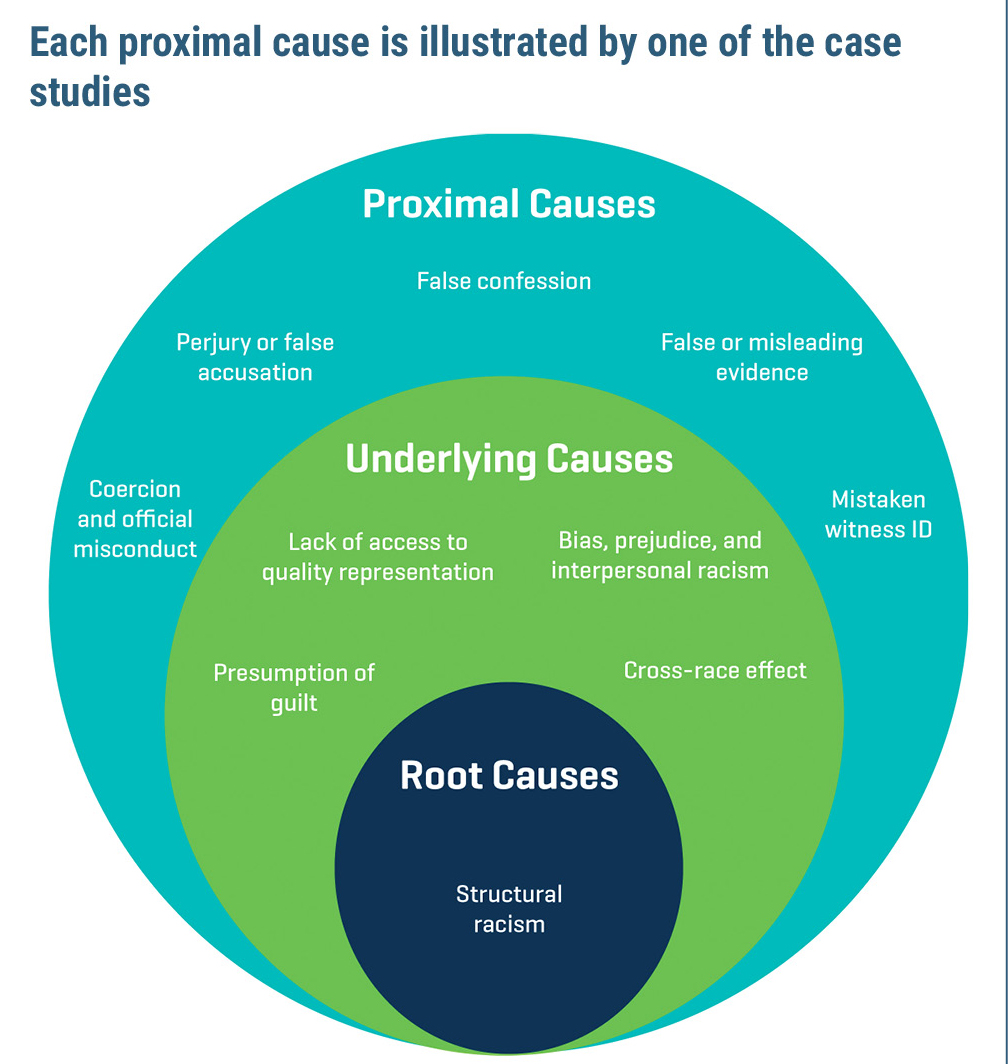
Causes of wrongful convictions.
Throughout Lesson 6 students look at the role that systemic racism has on creating and enforcing implicit biases such as the presumption of guilt. Students explore three levels of racism (internalized, interpersonal, and systemic) and the biological reasons biases can arise. Racial implicit biases arise when cognitive shortcuts used by our brain to make decisions quickly are primed by racist cultural messaging to result in false assumptions about entire communities of people (Jones 2000). These implicit biases (alongside explicit ones) are often enacted violently by the criminal legal system.
How can DNA technology be used in service of social justice? (Lesson 7)
Finally, groups of students create action plans, choosing a key concept from the lessons and applying it to a problem within the criminal legal system in their communities as a final assessment. Students choose a problem within the criminal legal system that they want to focus on and after some research and a stakeholders organization analysis, propose an intervention. This proposed intervention is their action plan that they will enact and share with the rest of the class in a gallery walk. The lesson includes a scaffold that supports students in developing a plan as well as a rubric for the teacher. This assessment allows students to apply their new scientific knowledge and argumentation skills to real-world problems while also learning how to advocate for change (Mackenzie 2020). Collaborating educators have also incorporated poetry and art into their assessment to scaffold students’ social and emotional processing of the material (Kraig-Turner 2020).
Classroom experience
These lessons have been piloted by teachers in both face-to-face and virtual classroom settings. One teacher taught the sequence in two consecutive biotech/forensics classes, and four additional teachers taught lessons in introductory biology and biotech classes. Science teachers who used these lessons reported this was a welcome opportunity to reorient their DNA unit around a socially relevant topic. One teacher who used this curriculum after the murder of George Floyd and during the peak of Black Lives Matter protests in 2020 noted that students were able to make connections between the social injustices happening in the news and their work in the science classroom (Figure 8).

Example student work from a Padlet
We collected survey data from students who piloted the curriculum materials (N = 47 presurvey, N = 46 postsurvey. Results from students in three public school biotech and biology classes are presented in Figures 9 and 10. For the statement, “Science can help address social issues,” the presurvey average score was 3.6 (Between Neutral/Agree), whereas the postsurvey average was 3.9 (Agree) on a scale from 1 to 5 (1 = Strongly Disagree and 5 = Strongly Agree). In the presurvey, no students strongly agreed that science can help address social issues, while in the postsurvey, nine students did. For the statement, “Talking about social issues related to biology helps me understand biology better,” the presurvey average score was 3.3 (Neutral), whereas the postsurvey average was 3.7 (Agree).
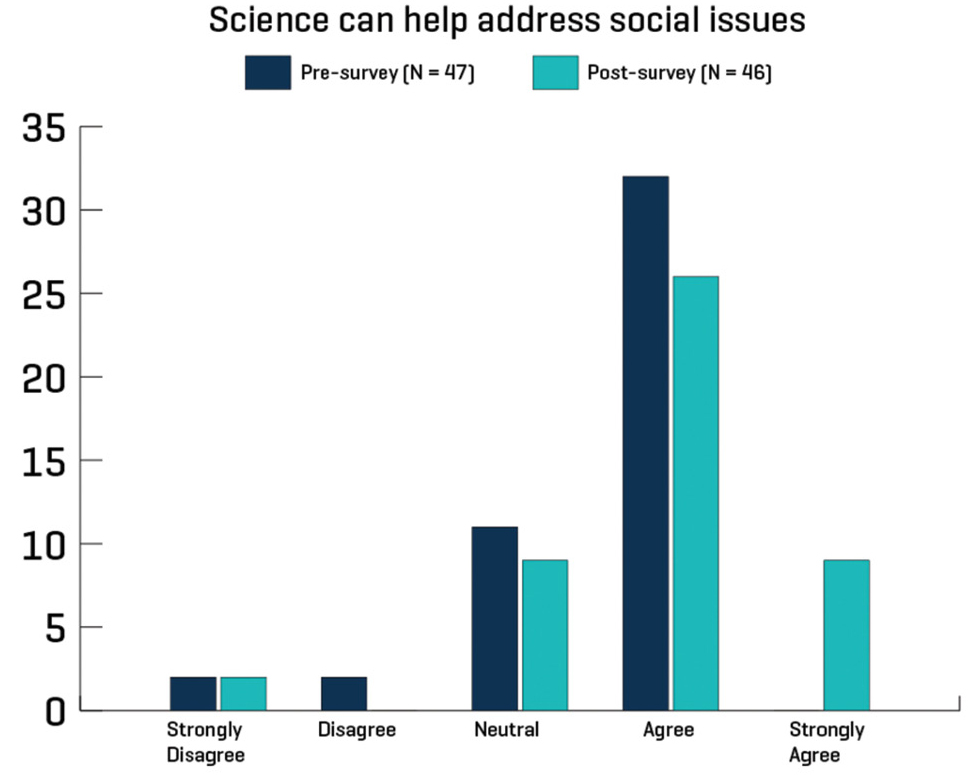
Student pre- and postsurvey data: “Science can help address social issues”

Student pre- and postsurvey data: “Talking about social issues related to biology helps me understand biology better”
After completing this unit, students reported feeling empowered by their knowledge to educate others and use scientific data to support their conclusions. They recognized that bias and structural factors contribute to differences in the frequency of wrongful convictions between racial groups. One student noted, “We have started to recognize the injustice and exonerate more [Black people] for crimes they either have not committed or were charged more harshly for than a non-person-of-color but this is hardly a start to fixing a broken, outdated system.”
Most students emerged from the first six lessons feeling strongly that the current criminal legal system was deeply flawed. They were then able to channel this energy into designing their action plan. Action plans and recommendations varied among the test classes and included strategies such as revamping interrogation techniques (including recording all interrogations), examining ways to reduce incarceration rates for nonviolent drug crimes and starting a social media campaign aimed at raising awareness among future jurors. Upon learning about the “presumption of guilt” attributed to Black people (Lesson 5), one student developed a plan related to changing school disciplinary policies.
Conclusion
The simple act of flipping the scenario of the traditional CSI or forensics lab to an exonerations lab allows science teachers to contextualize the use of DNA technology and connect it to the racialization present in mass incarceration practices. This small change “makes present and problematizes” the current state of the criminal legal system, and also makes space for “legitimized discussions of the racialized dimensions of forensic science towards a more rightful presence…” for Black and other students from backgrounds disproportionately impacted by such disparities (Calabrese Barton and Tan 2020). The ability to apply scientific practices (such as analyzing and interpreting incarceration data/statistics and engaging in evidence-based argument based on DNA analysis) can help students understand the context of wrongful convictions more deeply and prepare them to combat the biases, racism, and systemic inequities that have led to our current state of mass incarceration and overpolicing of Black and other marginalized communities. This pedagogical strategy provides one example of how DNA technology and social justice can be integrated into science classrooms.
We acknowledge that no one set of lessons or curriculum will be enough to help make science education spaces more anti-racist and just. Such an effort requires teachers, curriculum designers, administrators, and education leaders to commit to continuously examining their own biases and privileges, and to strive to learn, grow, and do better. It is especially important that schools cease harsh and inequitable disciplinary practices that are disproportionately enacted against students of color, which result in feeding the “school to prison pipeline” and play a pivotal role in the injustices that these lessons highlight. We aspire to classroom environments that elevate the brilliance of each learner, make visible and support the varied forms of sense-making they bring to the classroom, provide opportunities for transformative agency, and build trusting relationships and community.
Hanako Osuga is Program Coordinator of the Science Education Partnership and Dr. Jeanne Ting Chowning (chowning@fredhutch.org) is Senior Director of Science Education at the Fred Hutchinson Cancer Center, Seattle, WA. Jason Foster, NBCT Biology, is a Science Educator at Evanston Township High School, Evanston, IL.
Biology Curriculum Equity Inclusion Instructional Materials Interdisciplinary Labs Lesson Plans Life Science Mathematics News Teaching Strategies Technology High School


